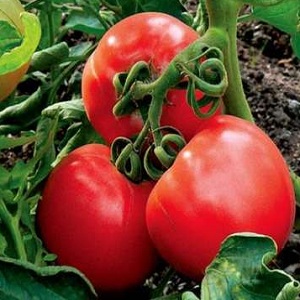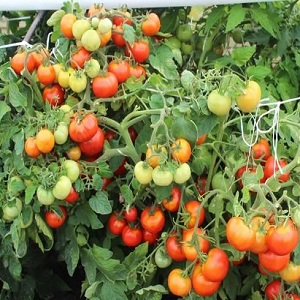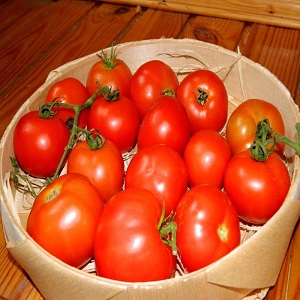If you want to get a rich harvest of sweet tomatoes with a rich taste - plant an Irina tomato on the plot
Tomato Irina f1 is one of the popular hybrids of domestic selection, created for cultivation in protected and unprotected soil. Unpretentious care, abundant fruiting and wonderful taste allow the culture to remain among the favorites among large farmers and amateur gardeners. Let's talk about the nuances of the agricultural technology of this culture in the greenhouse and the garden, its advantages and disadvantages.
The content of the article
Characteristics and description of the hybrid
Tomato Irina f1 is an early ripe hybrid created by biologists of the Scientific Research Center for Seed Breeding and Agricultural Engineering under the leadership of Yu. I. Panchev. The culture is suitable for growing in protected and unprotected ground.
Determinant bushes reach a height of 1–1.2 m, they need pinching and a garter. The first inflorescence is formed over 6-7 leaves, the subsequent ones - after 1-2 leaves.
In the photo - tomato Irina f1.

Distinctive features of the hybrid are presented in the table.
| Indicators | Characteristic |
| Weight | 130-140 g |
| The form | Flat-round |
| Fruit color | Red, without green spot at the stalk |
| Leaves | Medium green |
| Inflorescence | Intermediate |
| Pulp | Dense, juicy, with few seeds |
| Taste | Sweet |
| Skin | Dense, smooth, non-rigid |
| Number of nests | 4 and more |
| Peduncle | Articulated |
| Appointment | Universal |
| Ripening period | 90–93 days after germination |
| Yield | 16-18 kg / m² |
| Sustainability | To verticillosis, fusarium |
| Transportability | High |
Growing seedlings
The Irina hybrid is grown by the seedling method, followed by transfer to open or closed ground. Sowing work begins 50-60 days before planting in a permanent place.
Soil preparation and sowing seeds
Hybrid seeds do not need to be disinfected, as they are processed before packaging. To accelerate germination and increase the protective forces, the seed is soaked in stimulants ("Epin Extra", "Heteroauxin", "Radifarm", "Biostim", "Kornevin") according to the instructions on the package.
To obtain strong seedlings, a high-quality soil mixture is prepared:
- turf - 60%;
- humus - 30%;
- river sand - 10%.
Add to the bucket of soil:
- ammonium nitrate or carbonite - 20 g;
- superphosphate - 50 g;
- potassium sulfate - 20 g.
Before use, the soil is disinfected in an oven, microwave, double boiler or poured with a strong solution of potassium permanganate.
Seeds are sown in moist soil in special cassettes, ordinary plastic trays or boxes for seedlings to a depth of 1.5–2 cm with an interval of 2 cm. The containers are covered with plastic wrap and placed in a dark, warm place. The optimum room temperature is 25 ° C. The shelter is raised daily to avoid mold on the surface of the ground.
Care
After the first shoots appear, the film is removed, and the containers are placed on the windowsill from the south side. The air temperature is lowered to 16 ° C during the day and 14 ° C at night. This is necessary for the transition of sprouts from nutrition at the expense of seed reserves to nutrition at the expense of minerals from the soil.
Young shoots need enough light for normal growth and development. With a lack of lighting, phytolamps are installed. The norm of daylight hours is 16 hours.
To protect seedlings from stem and root rot, use the drug "Previkur". To prepare a 0.15% solution, you will need 15 ml of the product per 10 liters of water.The first treatment is carried out after removing the film cover, the next one - a week before transplanting to a permanent place.
Picking seedlings into individual plastic or peat cups is carried out at the stage of 2-3 true leaves.
Watering the seedlings is provided with moderate, in the morning, 1-2 times a week with settled water.
2 weeks after the pick, the seedlings are fed with a working solution based on nitroammophoska (30 g per 10 l of water). After feeding, the seedlings are watered with clean water to remove fertilizer residues. The second feeding is carried out 10 days before planting in the ground.
To increase resistance to late blight, Alternaria, brown spot 5 days before planting, seedlings are treated with a 0.5% solution of Bordeaux liquid.
Important! 2 weeks before transferring to a permanent place, the seedlings are taken out to fresh air for hardening for 30-60 minutes.
How to grow tomatoes
Irina hybrid agricultural technology is standard. To obtain a high yield and prevent diseases, nightshade bushes are stepchild, tied up, plentiful, but not frequent watering is organized, and they are fed with organic matter and mineral complexes.
Landing
Tomatoes prefer loose, fertile soil, so they prepare it in the fall. Dug up the beds, remove plant residues and fertilize with humus - 10 liters per 1 m². In the spring, the soil is loosened and fed with humus - 10 liters per 1 m².
In the beds, they dig holes 15–20 cm deep, fill them with a hot concentrated solution of potassium permanganate, add a handful of ash and 1 tbsp. l. superphosphate. Seedlings are planted in the prepared holes at a distance of 40 cm. The gap between the rows is 80 cm. No more than 3-4 bushes are planted per 1 m² in a checkerboard pattern.
Care
Tomato care rules:

- The bushes are watered with warm, settled or rainwater 1-2 times a week by sprinkling, in the morning, strictly at the root. The drip system allows watering at any time of the day.
- Weeding and loosening are carried out 1 time in 7 days.
- The beds are covered with mulch (peat, straw, sawdust, pine needles) to retain moisture, reduce weed growth and prevent bacteria and fungi.
- The lower yellowed leaves are regularly cut off.
- The bushes are formed into 1-3 stems by pinching.
- Stems and brushes with ovaries are tied to high stakes or trellis.
For the entire period of growth, tomatoes feed 3-4 times with an interval of 2 weeks. For the first feeding, nitrogen is used, for the next - mineral complexes.
Organic fertilizers based on mullein, chicken manure and wood ash are rich in nitrogen. They are used for root dressing:
- for 10 liters of water take 1 liter of mullein infusion, 1 liter of freshly cut grass infusion, a liter can of ash;
- 1 liter of water will need 20 g of chicken manure, the volume of the solution is brought to 10 liters;
- 10 liters of water will require 500 g of ash, after 3 days, filter the infusion through cheesecloth and water the plants.
For subsequent dressing use ready-made fertilizers: "Kemira Lux", "Bio Master", "Solution".
Options for mineral solutions (consumption per 1 m²):
- 20 g of superphosphate is infused for a day in 1 liter of boiling water and a working solution of 10 liters is prepared;
- 10 g diammophoska per 10 liters of water;
- 1 tbsp. l. nitroammophoska for 10 liters of water.
Growing features
Experienced farmers advise shaping the bushes into 1 stalk for an early harvest. When molded into 2-3 stems, the ripening period increases.
Grazing and removing leaves is a mandatory rule for caring for a hybrid. Dense plantings delay the ripening period due to the lower illumination of the fruit.
During the growing season, soil moisture is maintained at 70–80%, since the root system intensively absorbs moisture.
Diseases and pests
Tomato Irina is immune to the tobacco mosaic virus, verticillium and fusariumbut subject to cladosporium (brown spot). The disease is caused by the fungus Cladosporium fulvum Cooke. The pathogen spreads from bottom to top, affecting stems, leaves and fruits.First, small spots of a light green or yellow hue appear on the front side of the leaves. As the process develops, the spots turn brown and at the final stage they become dark brown. Leaves curl upward and rot.
At the first signs of cladosporium, tomato bushes are treated with fungicides "Bravo", "NeoTek", a solution of copper sulfate (1 tablespoon per 10 liters of water), colloidal sulfur (3 tablespoons per 10 liters of water).
Preventive measures will help prevent infection:
- compliance with crop rotation;
- airing greenhouses;
- spring soil treatment with copper sulfate;
- indoor humidity control;
- compliance with watering rules;
- soil mulching;
- removing the lower leaves so that they do not come into contact with the ground;
- periodic treatments (1 time in 2 weeks) with the preparations "Pseudobacterin-2", "Integral", "Fitosporin M".
The hybrid rarely suffers from late blight, since early maturing plants do not have time to become infected. Preventive measures against cladosporiosis are also effective against late blight.
Of the pests, the tomato most often affects the Colorado potato beetle, whitefly and spider mite. Chemical agents help to fight them: "Strela", "Confidor", "Flumayt", "Borneo", "Iskra", "Fitoverm", "Decis Profi", "Aktara".
The nuances of growing in an open field and a greenhouse
It is preferable to plant the Irina hybrid on the plot on the south side, without drafts, both in the greenhouse and in the garden. The culture loves the sun, but in the heat, the bushes in the open area are shaded with a special net or agrofiber.
The best predecessors of tomatoes are radish, zucchini, white cabbage, dill, parsley, onion. It is recommended to avoid areas where tomatoes, eggplants and peppers were grown. Crops of one family severely deplete the soil, so it takes at least 3 years to restore the mineral balance.
To accelerate the formation of ovaries and increase productivity, foliar treatments are carried out with phytohormones: "Kornevin", "Epin Extra", "Zircon", "Ovary", "Bud". Plants are sprayed in the evening in calm weather. The solution is prepared on the day of processing.
Harvesting and application of the crop

The fruit has a rich sweet taste. They contain about 3% sucrose and up to 6% dry matter. Tomatoes are characterized by their versatility in cooking: they are suitable for fresh consumption and for making soups, sauces, tomato paste, juice, snacks, vegetable caviar, lecho, adjika. Thin but dense skin does not crack during heat treatment, which allows preserve tomatoes in a hot marinade.
The harvested crop perfectly tolerates long-distance transportation, retains its taste and presentation.
Advantages and disadvantages
Hybrid advantages:
- high productivity;
- early maturity;
- immunity to nightshade diseases;
- large-fruited;
- high level of transportability;
- long-term fruiting;
- the ability to set fruits in adverse weather conditions;
- pleasant taste and aroma.
The disadvantage is the need to form and tie the bushes.
Reviews
There are mostly positive reviews about the Irina f1 hybrid. Gardeners note high productivity, ease of maintenance and excellent taste.
Julia, Shakhty: «I grow in a greenhouse about 6 hybrids for sale, including Irina's tomato. The culture is liked for its extraordinary productivity, early maturity, resistance to most diseases. My tomatoes rarely suffer from late blight and brown spot, because I devote a lot of time to preventive treatments. "
Igor, Starodub: “I got acquainted with this variety of tomatoes recently. I was looking for suitable seeds for open ground. I liked the tomato very much, feels good in the garden, ripens early, rarely gets sick. I water it abundantly at the root once a week. They are fed with nitrogen, potassium and phosphorus. Tomatoes have excellent taste, juicy and aromatic, suitable for rolling into a jar. "
Conclusion
Tomato Irina f1 is a high-yielding hybrid with good immunity and resistance to cold. The culture is suitable for growing in all regions of Russia in protected and unprotected ground.
Compliance with the rules of agricultural technology (abundant watering, feeding, pinching, preventive treatments for fungi and insects) makes it possible to collect up to 18 kg of selected tomatoes from 1 m². Extended fruiting allows you to enjoy sweet fruits for a long time.